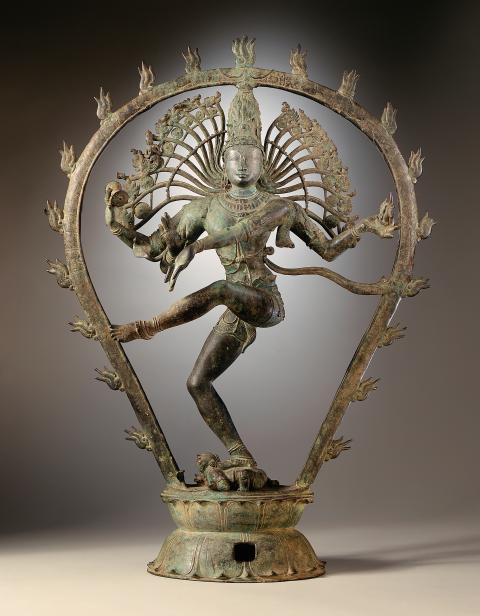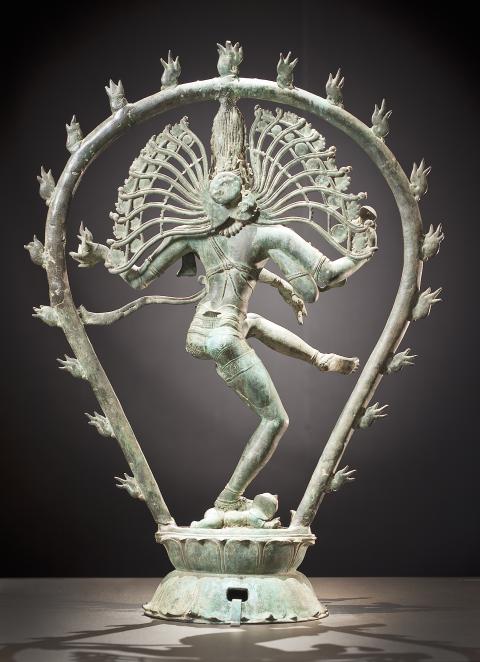The Hindu trinity of supreme divinity — the Trimurti — consists of Brahma the creator, Vishnu the preserver and Shiva the destroyer. Hindu cosmology includes the endless cycle of destruction and rebirth, in which destruction entails eradicating worldly delusion and imperfection, to facilitate transformation. Therefore, the deity of destruction represents not calamity, but instead a formidable regenerative force. It is for this reason that Shiva is worshipped.
Shiva has many guises, and this bronze sculpture is a classic work representing the deity as Nataraja, the Lord of Dance. Shiva’s dance is known as the cosmic dance, the energy that sets the universe in motion. Dancing between ecstasy and fury, the cosmos is destroyed only to emerge once again.
Details such as posture and gesture in religious sculpture generally have symbolic meaning in iconography, and this sculpture is no exception. The halo of flames surrounding the statue represents the universe. The drum Shiva is holding in his right hand on the rear pair of arms symbolizes the creation of the universe, while the flame held in his left hand on the rear pair of arms represents destruction. The right hand of his fore pair of arms is making the abhaya mudra gesture of fearlessness. The god’s right foot is standing on the dwarf Apasmara, who represents ignorance. This form of Shiva as Lord of Dance first appeared during the southern Indian Chola Dynasty (4th to 13th century BC), and was transmitted far and wide.

Photo courtesy of Los Angeles County Museum
照片:洛杉磯郡立美術館提供
Shiva was both the god of music and dance. Legend has it that he was the originator of dance, and could perform 108 types of dance, both feminine and masculine. Shiva’s Lord of Dance form is androgynous: Clean shaven, elegant and dignified.
(Translated by Paul Cooper)
印度神話中的三位主神是創造之神梵天、維護之神毗濕奴,以及毀滅之神濕婆。印度教的宇宙觀是不斷的毀滅與重生的循環──毀滅,是要破壞世上的虛幻與不完美,以促成轉變──因此毀滅之神不但不是災難性的,反而是代表強大無比的再生力量,濕婆因此極受崇拜。

Photo courtesy of Los Angeles County Museum
照片:洛杉磯郡立美術館提供
濕婆有許多種「相」,這件銅雕所呈現的是濕婆「舞蹈之王」相的典型作品。濕婆的舞蹈被稱為「宇宙之舞」,是運轉宇宙的動能──在跳舞的狂喜與狂怒中,宇宙灰飛煙滅、風雲再起。
宗教造像的舉手投足等細節,往往都有圖像學的象徵意義,這件雕塑也不例外:有火焰的外環代表宇宙,濕婆的後方右手拿著象徵宇宙創造的鼓,後方左手托著的火焰代表毀滅,前方右手呈「無畏印」的手勢;祂的右腳所踩的是象徵無知的小鬼。這樣的濕婆舞王像結構在南印度朱羅王朝(西元四世紀至十三世紀)時期出現,並廣為流傳。
濕婆也是音樂及舞蹈之神──傳說祂是印度舞蹈的始祖,會跳一百零八種舞,包括女性的柔軟舞,以及男性的剛健舞。濕婆舞王像無鬚、姿態優美、華麗莊嚴,有如雌雄同體。
(台北時報林俐凱)

★ Bilingual Story is a fictionalized account. 雙語故事部分內容純屬虛構。 “Get in. It’s pouring.” She slid into the back seat, drenched and silent. “Tissues?” the driver asked. “No, thank you,” she said. Water beaded off her hair, ran from her coat, and made a small lake on the vinyl. She kept her head down, long black strands clinging to her face. “Where to?” She gave an address. “Funeral?” he asked as they slipped into the Xinhai Tunnel, rain fading to a hollow drum. She glanced up, puzzled. “No. Why?” “Crematorium’s about the only thing here.” He caught her eyes in the mirror.

Have you ever dreamed of hiking Taiwan’s majestic Mt. Jade or visiting Peru’s breathtaking Machu Picchu? These adventures sound amazing, but there’s something you should know about first: “altitude sickness.” This condition strikes when you climb to a higher elevation too quickly. The higher you go, the thinner the air becomes, making it harder for your body to absorb oxygen. The symptoms usually begin within hours of reaching high altitudes — about 2,500 meters or higher. You might experience headaches, dizziness, nausea, shortness of breath, or extreme fatigue. These symptoms can last for several days. The severity of altitude sickness varies

A: Any fun events happening this weekend? B: Boyband Energy’s concerts and Taiwan’s first major male dance revue have both sparked anticipation recently. A: Energy staged a comeback last year — 15 years after they disbanded — and they’re now more popular than ever. B: Their megahit “Friday Night” even won Song of the Year at the Golden Melody Awards. A: To pay tribute to the Queen of Pop Madonna, they added her choreography of 16 continuous jump squats to their music video, prompting a “16-squat challenge” that went viral across Taiwan. Do you wanna try it out? A:

Week 24 詞法—名詞 1. 人們一致稱讚他。 ˇ People praised him unanimously. χ Peoples praised him unanimously. 註:people 作「人們」(= men and women)解時,是單數形式,作複數用。peoples 是「多個民族」、「各國人民」,不是「多數人」,如 the peoples of Asia(亞洲各民族、亞洲人民)。 2. 她為他做了一條新褲子。 ˇ She made him a new pair of trousers. χ She made him a new trousers. 註:scissors 和 trousers 等名詞習慣用複數形式。「一把剪刀」或「一條褲子」正統說法為 a pair of scissors 或 a pair of trousers。 3. 我們提前兩年完成了第二個五年計劃的主要目標。 ˇ We fulfilled the major objectives of the Second Five-Year Plan two years ahead. χ We fulfilled the major objectives of the Second Five-Years Plan two years ahead. 註:five-year 作為一個複合形容詞,year 不用複數。又如 a twelve-year-old boy、a five-dollar note、a one-hundred-meter race 等,也是一樣。 4. 他們決定買一輛新車。 ˇ They have made up their minds to buy a new car. χ